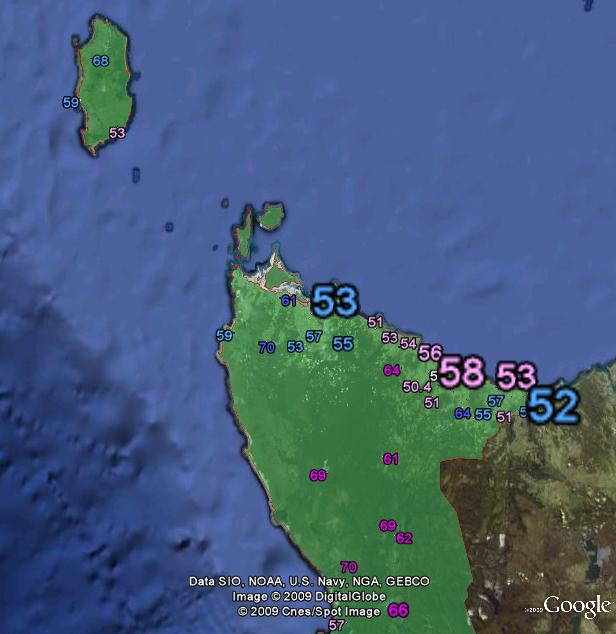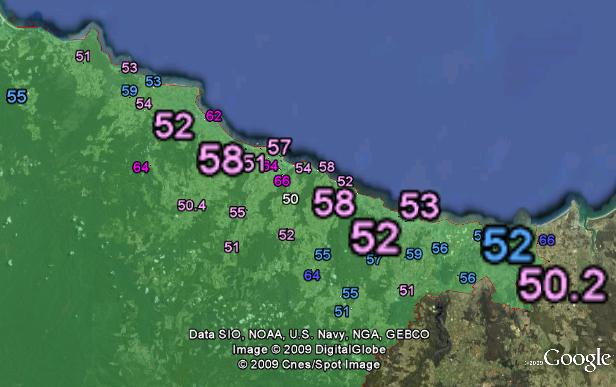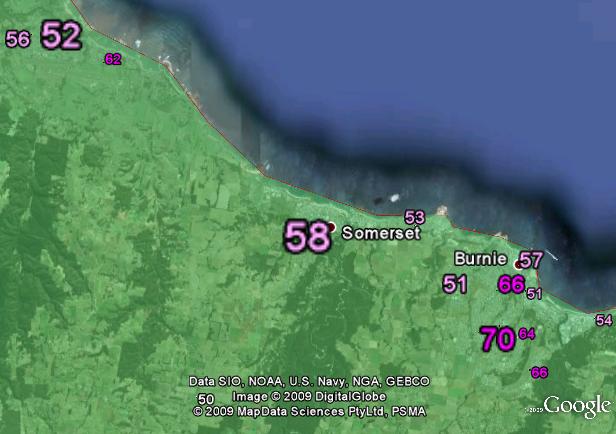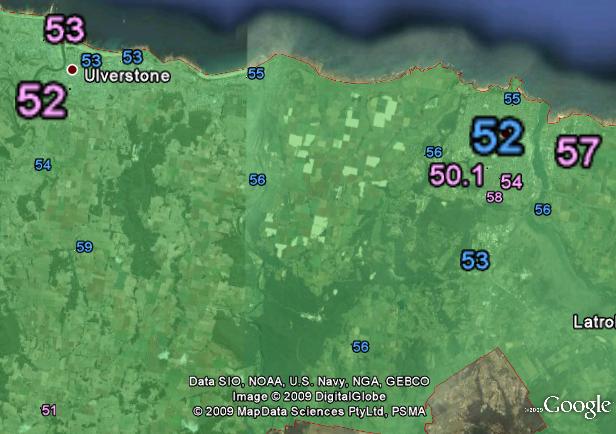ALP 2.3%
Incumbent MP
Sid Sidebottom since 2007, previously held the seat 1998-2004.
Geography
Braddon covers the West Coast and North-West of Tasmania, including the islands to Tasmania’s northwest. The seat covers West Coast, Burnie, Central Coast, Circular Head, Devonport and Waratah/Wynyard councils along with part of Latrobe council. It also covers King Island. The seat’s largest centres are the towns of Devonport and Burnie.
Redistribution
The redistribution saw Braddon change from being a strictly northwestern seat to stretch down to cover the west coast. West Coast LGA was transferred from Lyons to Braddon, and in compensation part of Latrobe LGA (which had previously been entirely within Braddon) was transferred to Lyons. Urban Latrobe remained in Braddon while the rural parts of the LGA, including Port Sorell, moved to Lyons. This redistribution increased Labor’s two-party-preferred margin from 1.4% at the 2007 election to a notional 2.3% margin. The seat remains very marginal, but has become safer with the inclusion of West Coast LGA.
Demographics
Braddon has below-average income levels. The manufacturing industry is a major employer, with a much higher proportion of Braddon’s workers employed in manufacturing than the state or national average. In contrast, levels of employment in professional occupations is well below average.
History
The seat of Braddon was created in 1955 when the existing Divison of Darwin was renamed. The seat of Darwin was created in 1903 for the first election with single-member electorates in Tasmania, and has always been a northwestern electorate. The seat of Darwin/Braddon has been largely dominated by conservative parties, with Labor holding the seat for 37 of the seat’s first 104 years up to 2007.
The seat was first won by the ALP’s King O’Malley, who held the seat until 1917. O’Malley is best-known for his service as Minister for Home Affairs under Andrew Fisher which saw him take responsibility for choosing the site and town plan for Caberra. He was also largely responsible for the Americanised spelling of the name of the Australian Labor Party. He was strongly anti-conscriptionist and his term as a minister ended when the ALP split, with Billy Hughes joining with the Liberals to form the new Nationalist government. At the 1917 election, O’Malley was narrowly defeated by a Nationalist candidate, and the Nationalist parties and its successors held the seat for the next forty years, with the exception of a single term in 1922 when the seat was held by the nascent Country Party.
The most prominent MP to represent Darwin during this period was Enid Lyons, widow of former Prime Minister Joseph Lyons, who was the first woman elected to the House of Representatives in 1943 and held the seat until the 1951 election.
After the seat was renamed Braddon in 1955, the ALP won the seat back in 1958. Ron Davies held the seat for the ALP up to the post-dismissal election in 1975, when he was defeated by the Liberal Party’s Ray Groom, who held the seat until 1984. He went on to enter state politics and was Premier from 1992 to 1996. Chris Miles succeeded Groom in Braddon and held the seat for the Liberal Party up to the 1998 election, when he was defeated by Sid Sidebottom. Sidebottom held the seat for the ALP from 1998 to 2004, when he lost the seat to Liberal Mark Baker in a backlash against Mark Latham’s forestry policies. Sidebottom regained the seat in 2007.
Candidates
- Garry Carpenter (Liberal)
- Scott Jordan (Greens)
- Sid Sidebottom (Labor) – Member for Braddon 1998-2004 and since 2007.
Political situation
This seat is a very marginal seat and will always be at danger of falling to the Liberal Party, although Sidebottom will be a strong contender in 2010.
2007 result
| Candidate | Party | Votes | % | Swing |
| Mark Baker | LIB | 29,152 | 44.00 | -3.36 |
| Sid Sidebottom | ALP | 28,948 | 43.69 | +0.64 |
| Paul O’Halloran | GRN | 5,392 | 8.14 | +2.53 |
| Wayne de Bomford | FF | 2,135 | 3.22 | -0.76 |
| Peter Cunningham | LDP | 321 | 0.48 | +0.48 |
| Stephen Dick | CEC | 313 | 0.47 | +0.47 |
2007 two-candidate-preferred result
| Candidate | Party | Votes | % | Swing |
| Sid Sidebottom | ALP | 34,085 | 51.44 | +2.57 |
| Mark Baker | LIB | 32,176 | 48.56 | -2.57 |
These results do not take into consideration the effects of the redistribution.
Booth breakdown
Braddon consists of seven complete local government areas as well as part of Latrobe LGA, which is split with Lyons. Two thirds of ordinary votes at the 2007 election were cast in three neighbouring LGAs in the northeastern corner of the electorate: Devonport, Central Coast and Burnie LGAs. Devonport and Central Coast are both extremely marginal areas, with the ALP winning Devonport with 50.35% and the Liberal Party winning Central Coast with 50.3%.
Latrobe LGA, to the east of Devonport, is also extremely marginal, although a large proportion of the LGA has been transferred to Lyons. Burnie LGA, where one in five ordinary votes were cast in 2007, is strongly pro-Labor, with the ALP winning over 59% of the two-party-preferred vote in 2007.
Waratah/Wynyard is marginally ALP while Circular Head LGA, in the northwestern corner of the Tasmanian mainland, was won for the Liberal Party with a 54.2% vote. West Coast LGA voted for the ALP solidly in 2007, with the party winning 64.6% of the two-party-preferred vote. It is important to note that West Coast was part of Lyons in 2007, which was much less marginal than Braddon and much less heavily contested. King Island votes solidly for the Liberal Party, however the entire island cast less than 1000 votes in 2007.
| Voter group | GRN % | ALP 2CP % | Total votes cast | % of ordinary votes |
| Devonport | 6.87 | 49.65 | 14,313 | 24.92 |
| Central Coast | 9.21 | 50.28 | 12,749 | 22.20 |
| Burnie | 6.86 | 59.25 | 11,130 | 19.38 |
| Waratah/Wynyard | 10.19 | 54.78 | 8,211 | 14.30 |
| Circular Head | 5.94 | 45.63 | 4,710 | 8.20 |
| Latrobe* | 6.88 | 47.93 | 2,952 | 5.14 |
| West Coast | 6.95 | 64.55 | 2,446 | 4.26 |
| King Island | 5.99 | 41.83 | 918 | 1.60 |
| Other votes† | 10.11 | 50.74 | 8,684 |
*About half the population of Latrobe LGA was transferred from Braddon to Lyons in the redistribution. This figure is based on an estimate of the vote in the remaining part of Latrobe.
†Not adjusted for the redistribution.






West Coast LGA also has a significant mining industry, employing over 20% of the workforce, which helps account for the high Labor vote.
I like the way you’re breaking the electorates up into the voter groups.
Very nice Ben. It’s only speculation at this point but I’m told that Mark Baker is weighing up whether the seat is winnable for the Libs again and thus whether he should contest preselection.
Defeated state member Brett Whiteley is a potential starter for the Liberals here. Also named as a possible candidate is ‘footballing identity’ Gary Carpenter.
And just to complete the rounds on the Tassie electorate threads, big bad Brett is still pretty sooky about losing his state seat and is therefore still pretty cagey about whether he will run or not.
I think there’s a pretty strong campaign to be run for the Libs in Braddon by whipping up fear about the new Labor/Green state government and arguing that voters need to elect a Liberal who will fight for the electorate in Canberra even if those durn southerners who lead the state coalition neglect it.
Whiteley was quite a headkicker and one of the Libs’ sharper tactical brains in the previous state parliament but he has a reputation as a divisive hardliner which probably contributed to his state defeat. If he ever got to Canberra it would make for some fireworks but he has said state politics is his world so I don’t know if we’ll see it happen.
http://www.abc.net.au/news/stories/2010/06/11/2924836.htm
Whitely rules out running for Braddon federally.
Says that ‘it is likely he will run at the next state election.’
Just beat me to it.
Garry Carpenter is the Liberal candidate.
My prediction: Tough call. Sidebottom probably to retain it, but unsure if he’ll get a swing to him or against him.
I’m predicting similar result here to Bass.